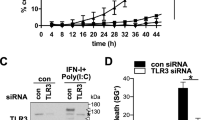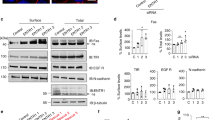Abstract
Epidermal growth factor receptor (EGFR) plays a critical role in cell proliferation, differentiation, and transformation. EGFR downregulation attenuates its signaling intensity and duration to maintain cellular homeostasis. Here, we report that during apoptosis EGFR is cleaved by activated caspase-3 or related proteases at its C-terminus domain. EGFR downregulation by activation of caspases is neither stimulus- nor cell type-specific. EGFR internalization during apoptosis required dynamin and cholesterol since dominant-negative dynamin (K44A) or cholesterol depletion by methyl-β-cyclodextrin prevented EGFR internalization. However, EGFR downregulation did not require its internalization. The EGFR cleavage fragment was detected in the membrane blebs in addition to the cell pellets. Mutations at the consensus sequence (DXXD) at the C-terminus domain revealed that DVVD1012 and to a lesser extent DNPD1172 may be target sites for active recombinant caspase-3 in vitro and activated caspase-3 or related proteases in vivo. We have detected the N-terminus and C-terminus fragments in vitro and in vivo. A cleavage-deficient EGFR mutant delayed apoptosis process. We conclude that the evolutionarily conserved C-terminus domain of EGFR is the target of caspases and subjected to degradation during apoptosis to shut down its signaling.
This is a preview of subscription content, access via your institution
Access options
Subscribe to this journal
Receive 50 print issues and online access
$259.00 per year
only $5.18 per issue
Buy this article
- Purchase on Springer Link
- Instant access to full article PDF
Prices may be subject to local taxes which are calculated during checkout









Similar content being viewed by others
Abbreviations
- Ad:
-
actinomycin D
- CA:
-
camptothecin
- CY:
-
cycloheximide
- DEVD (D):
-
DEVD-fmk,ZD(OMe)-E(OMe)-VD(OMe)-fluoromethylketone
- DX:
-
doxorubicin hydrochloride
- EGF:
-
epidermal growth factor
- EGFR:
-
EGF receptor
- EP:
-
etoposide
- FA-fmk (F):
-
Z-Phe-Ala-fluoromethylketone, a negative control for caspase inhibitor
- GM:
-
GM6001 or Ilomastat, a metalloprotease inhibitor
- HRP:
-
horseradish peroxidase
- MβCD (M):
-
methyl-beta-cyclodextrin
- N-EGFR:
-
anti-EGFR antibody recognizing its N-terminus (EGFR LA22)
- Neu:
-
the second member of the ErB family
- PA:
-
paclitaxel
- PDGFR:
-
platelet-derived growth factor receptor
- PU:
-
puromycin dihydrochloride
- rCas-3:
-
recombinant active human caspase-3
- RTKs:
-
receptor tyrosine kinases
- ST:
-
staurosporine
- UVA:
-
ultraviolet A (315–400 nm)
- UVB:
-
ultraviolet B (280–315 nm)
- VAD (V):
-
VAD-fmk, Z-Val-Ala-Asp (OMe) fluoromethylketone
References
Akunda JK, Lao HC, Lee CA, Sessoms AR, Slade RM, Langenbach R . (2004). FASEB J 18: 185–187.
Bae SS, Choi JH, Oh YS, Perry DK, Ryu SH, Suh PG . (2001). FEBS Lett 491: 16–20.
Benoit V, Chariot A, Delacroix L, Deregowski V, Jacobs N, Merville MP et al. (2004). Cancer Res 64: 2684–2691.
Clarke PG . (1990). Anat Embryol (Berl) 181: 195–213.
Coleman ML, Sahai EA, Yeo M, Bosch M, Dewar A, Olson MF . (2001). Nat Cell Biol 3: 339–345.
Conner SD, Schmid SL . (2003). Nature 422: 37–44.
Di Fiore PP, Gill GN . (1999). Curr Opin Cell Biol 11: 483–488.
Earnshaw WC, Martins LM, Kaufmann SH . (1999). Annu Rev Biochem 68: 383–424.
He YY, Huang JL, Chignell CF . (2004). J Biol Chem 279: 53867–53874.
He YY, Huang JL, Gentry JB, Chignell CF . (2003a). J Biol Chem 278: 42457–42465.
He YY, Huang JL, Ramirez DC, Chignell CF . (2003b). J Biol Chem 278: 8058–8064.
Heldin CH, Westermark B, Wasteson A . (1979). Nature 282: 419–420.
Herbst RS, Fukuoka M, Baselga J . (2004). Nat Rev Cancer 4: 956–965.
Hunter T . (1997). Cell 88: 333–346.
Johnstone RW, Ruefli AA, Lowe SW . (2002). Cell 108: 153–164.
Kagaya S, Kitanaka C, Noguchi K, Mochizuki T, Sugiyama A, Asai A et al. (1997). Mol Cell Biol 17: 6736–6745.
Kerr JF, Wyllie AH, Currie AR . (1972). Br J Cancer 26: 239–257.
Nusbaum P, Laine C, Bouaouina M, Seveau S, Cramer EM, Masse JM et al. (2005). J Biol Chem 280: 5843–5853.
Park IC, Park MJ, Choe TB, Jang JJ, Hong SI, Lee SH . (2000). Int J Oncol 16: 1243–1248.
Ricci JE, Munoz-Pinedo C, Fitzgerald P, Bailly-Maitre B, Perkins GA, Yadava N et al. (2004). Cell 117: 773–786.
Rodal SK, Skretting G, Garred O, Vilhardt F, van Deurs B, Sandvig K . (1999). Mol Biol Cell 10: 961–974.
Rowinsky EK . (2004). Annu Rev Med 55: 433–457.
Stennicke HR, Renatus M, Meldal M, Salvesen GS . (2000). Biochem J 350(Part 2): 563–568.
Subtil A, Gaidarov I, Kobylarz K, Lampson MA, Keen JH, McGraw TE . (1999). Proc Natl Acad Sci USA 96: 6775–6780.
Thompson CB . (1995). Science 267: 1456–1462.
Tulasne D, Deheuninck J, Lourenco FC, Lamballe F, Ji Z, Leroy C et al. (2004). Mol Cell Biol 24: 10328–10339.
Ullrich A, Schlessinger J . (1990). Cell 61: 203–212.
Wyllie AH, Kerr JF, Currie AR . (1980). Int Rev Cytol 68: 251–306.
Zhuang S, Ouedraogo GD, Kochevar IE . (2003). Oncogene 22: 4413–4424.
Acknowledgements
The research was supported by the intramural research program of the NIH, the NIEHS. We thank Jeff Reece for his help with confocal microscopy measurements, and Carl Bortner for his help with flow cytometry. We thank John O'Bryan for helpful discussion. We are also grateful to Drs Ann Motten and Jie Liu for critical reading of the manuscript.
Author information
Authors and Affiliations
Corresponding author
Rights and permissions
About this article
Cite this article
He, YY., Huang, JL. & Chignell, C. Cleavage of epidermal growth factor receptor by caspase during apoptosis is independent of its internalization. Oncogene 25, 1521–1531 (2006). https://doi.org/10.1038/sj.onc.1209184
Received:
Revised:
Accepted:
Published:
Issue Date:
DOI: https://doi.org/10.1038/sj.onc.1209184
Keywords
This article is cited by
-
Targeted delivery of irinotecan to colon cancer cells using epidermal growth factor receptor-conjugated liposomes
BioMedical Engineering OnLine (2022)
-
Quantitative Analysis of the Rewiring of Signaling Pathways to Alter Cancer Cell Fate
Journal of Medical and Biological Engineering (2020)
-
Disulfide bond-disrupting agents activate the tumor necrosis family-related apoptosis-inducing ligand/death receptor 5 pathway
Cell Death Discovery (2019)
-
Stress-induced endocytosis and degradation of epidermal growth factor receptor are two independent processes
Cancer Cell International (2016)
-
Interaction of EGFR to δ-catenin leads to δ-catenin phosphorylation and enhances EGFR signaling
Scientific Reports (2016)



